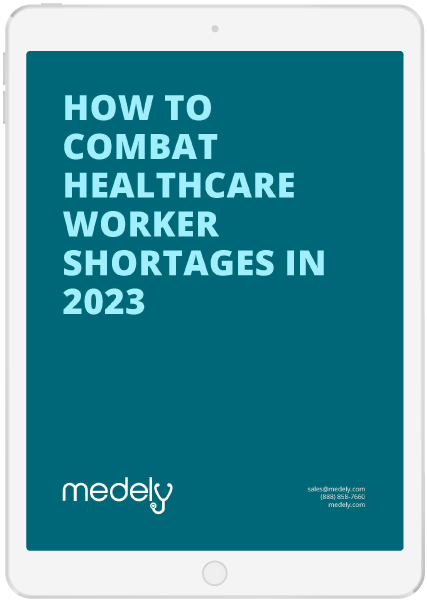After a crisis-driven surge in demand for nurses and allied professionals over the past year, service delivery at hospitals and outpatient facilities is starting to even out. That’s giving healthcare facility administrators a chance to rethink their needs in the face of post-COVID short term nurse staffing trends that have started to emerge:
- Budgets are tight as facilities work to reset the balance between costs, requirements, nurse-patient ratios, placement speed, and quality patient care.
- Healthcare professional shortages have been amplified; burnout is a very real issue and permanent nurse vacancies are higher than they were before the pandemic, making retention and recruitment even more top of mind.
- Measures prompted by the pandemic, such as expanded Nursing Licensure Compact (NLC) legislation, are creating potential opportunities for broader recruitment efforts.
- Accelerated implementation of telemedicine and other IT solutions have shifted some staffing requirements.
Short term nurse staffing solutions have long been a way to bridge regular fluctuations between supply and demand. As the healthcare industry finds its footing, the flexibility of temporary assignment jobs may help provide the support it needs to recover.
Short Term Nurse Staffing Option 1: Travel Nursing
Demand for travel nurses skyrocketed 35% at the peak of COVID-19, as did rates and incentives. But that’s starting to reset: A report from SIA projects less demand (and lower wages) this year, declining further to a drop of 20% in 2022.
Travel nursing assignments typically run from four to 12+ weeks and attract a broad group of professionals who appreciate flexibility, are highly focused on patient care, and know how to adapt. This open-mindedness can work in your favour, particularly if you can find ways to position your travel assignment location so it speaks to that desire for new and memorable experiences.
Working with travelers is ideal for managers who can forecast their staffing requirements ahead of time. While some travel nurses are newer graduates with a few years of clinical experience behind them, others are highly experienced nurses with the skills needed for specialized or high-demand positions that can’t be filled locally.
Pros and cons of working with travel nurses
- Pro: Exposure to a wide range of situations makes them adaptable
- Pro: There’s often the potential for extension contracts if the relationship is a good fit
- Con: Requires orientation and training with regards to tools, systems, and processes
- Con: Lead time is required to hire a nurse with the skills and experience your facility needs
Short Term Nurse Staffing Option 2: Local Assignment
Sometimes you need access to quality talent that’s already nearby for assignments that can last a month or longer, such as planned periods of leave or unexpected absences. This can help you avoid credentialing issues that can come up if you have to expand your search to other states.
This is a group that has different motivations than travel nurses and control over their schedule can be a key motivator. The professional could be a parent who’s only available during certain periods during the year; it could be someone who’s recently retired and isn’t interested in the commitment of a permanent placement.
Regardless, one challenge of local assignments is the impact of the overall nursing shortage: You may have a limited talent pool to draw on and it might be even more difficult to find the expertise you need. It helps to have extra time in case you do need to expand your search.
Pros and cons of local assignments
- Pro: May already be familiar with your facility as well as its staff and processes
- Pro: Opportunity to build longer-term relationships for future high-demand periods
- Con: Need time to broaden search if the local search comes up empty
- Con: A Pro in your area may not be available to start when you need them, requiring a Travel Professional instead
Short Term Nurse Staffing Option 3: Per Diem Nursing
Demand for per diem nurses increased somewhat as a result of the pandemic, but overall demand is expected to stay relatively stable—which will help keep a healthy pool of talent available to support facilities.
Per diem nurses and allied professionals are available as needed, maybe for a day or a particular shift when someone calls in sick or staffing is otherwise short.
Due to the last-minute nature of per diem work, it can be hectic for everyone involved so it tends to be filled on a “first come, first served” basis. This is great because you can potentially fill the spot in minutes—but fit is far less important.
Pros and cons of per diem assignments
- Pro: Your immediate need is addressed with as little disruption as possible
- Pro: Healthcare professionals are typically very adaptable because they’ve had exposure to a wide range of situations
- Con: You may not always find someone who’s available
- Con: They may have no familiarity with your facility or staff
- Con: Requires speedy orientation and training with regards to tools, systems, and processes
Conclusion
Short-term assignments aren’t always the right solution. But for a lot of healthcare facilities, flexible access to talent is exactly what’s needed as they redefine what business as usual looks like.
Need help finding the trusted healthcare workers your facility is looking for? Learn more about how Medely can help.

How to effectively combat healthcare labor shortages in 2024
Learn how to effectively combat healthcare labor shortages with an extended workforce to maintain continuity of care and gain access to tools you can use to manage your extended workforce more effectively and efficiently. In this eBook, you’ll learn:
- ■ Why nurses are leaving full-time jobs behind.
- ■ The factors impacting healthcare professional employment.
- ■ How you can use an extended workforce to meet demand.
- ■ How you can use data-led staffing planning to manage costs.
